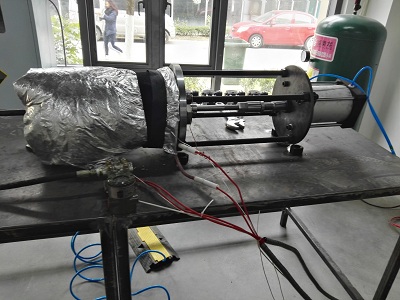
2016-11-11 Rongda test 1002 times

Detection Purpose: Inspection of tensile fatigue properties of metallic materials
Detection range: Petroleum pipeline, pressure vessel, boiler, liquefied gas tank, valve, flange, weld, carbon steel,
Tensile fatigue test: the sudden fracture of materials and mechanical parts under the action of alternating stress, which develops under several cycles of stress far lower than the yield strength of Materials & sigma; s. At present, the basic method to evaluate the fatigue performance of metal materials is to measure its S-N curve (fatigue curve) by test, that is to establish the relationship curve between the maximum stress & sigma; max or stress amplitude & Sigma & alpha; and its corresponding fracture cycle n. The S-N curve shapes of different metal materials are different, which can be roughly divided into two categories, as shown in Figure 1. One type of curve starts to show obvious horizontal part below a certain stress level, as shown in Figure 1 (a). This shows that when the applied alternating stress decreases to this level, the specimen can withstand infinite stress cycles without fracture. (a) S-N curve with obvious horizontal part; (b) S-N curve without obvious horizontal part Fig. 1 S-N curve of metal This shows that when the applied alternating stress decreases to this level, the specimen can withstand infinite stress cycles without fracture. Therefore, the stress corresponding to the horizontal part is called the fatigue limit of the metal, which is represented by the symbol & sigma; R (R is the ratio of the minimum stress to the maximum stress, which is called the stress ratio). If the test is carried out under symmetrical cyclic stress (i.e. r = - 1), the fatigue limit is expressed as & sigma; - 1. The S-N curve of medium and low strength structural steel, cast iron and other materials belongs to this category. For this kind of material, when testing its fatigue limit, it is impossible to achieve infinite stress cycle, and the test shows that under the action of alternating stress, if the stress cycle reaches 107 cycles without fracture, it indicates that it can withstand infinite stress cycle without fracture, so 107 cycles are commonly used as the base for determining the fatigue limit for this kind of material. The other kind of fatigue curve has no horizontal part. Its characteristic is that with the decrease of stress, cycle n increases continuously, but there is no infinite life. As shown in Figure 1 (b). In this case, the stress corresponding to a certain number of cycles (108 or 5 & times; 107 & hellip;) is often determined according to the actual needs as the "conditional fatigue limit" of metal materials, which is expressed by the symbol & sigma; R (n).
Last article: NO!
Next article: NO!